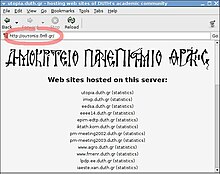
Back اسم نطاق إنترنت دولي Arabic Nom de domini internacionalitzat Catalan IDN Czech Internationalisierter Domainname German İnternasyonel namey domaini DIQ Nombre de dominio internacionalizado Spanish آیدیان Persian Nom de domaine internationalisé French अन्तरराष्ट्रीयकृत डोमेन नाम Hindi Nemzetközi tartománynév Hungarian

An internationalized domain name (IDN) is an Internet domain name that contains at least one label displayed in software applications, in whole or in part, in non-Latin script or alphabet[a] or in the Latin alphabet-based characters with diacritics or ligatures.[b] These writing systems are encoded by computers in multibyte Unicode. Internationalized domain names are stored in the Domain Name System (DNS) as ASCII strings using Punycode transcription.
The DNS, which performs a lookup service to translate mostly user-friendly names into network addresses for locating Internet resources, is restricted in practice[c] to the use of ASCII characters, a practical limitation that initially set the standard for acceptable domain names. The internationalization of domain names is a technical solution to translate names written in language-native scripts into an ASCII text representation that is compatible with the DNS. Internationalized domain names can only be used with applications that are specifically designed for such use; they require no changes in the infrastructure of the Internet.
IDN was originally proposed in December 1987 by Martin Dürst[1][2] and implemented in 1990 by Tan Juay Kwang and Leong Kok Yong under the guidance of Tan Tin Wee.[citation needed] After much debate and many competing proposals, a system called Internationalizing Domain Names in Applications (IDNA)[3] was adopted as a standard, and has been implemented in several top-level domains.
In IDNA, the term internationalized domain name means specifically any domain name consisting only of labels to which the IDNA ToASCII algorithm (see below) can be successfully applied. In March 2008, the IETF formed a new IDN working group to update[4] the current IDNA protocol. In April 2008, UN-ESCWA together with the Public Interest Registry (PIR) and Afilias launched the Arabic Script in IDNs Working Group (ASIWG), which comprised experts in DNS, ccTLD operators, business, academia, as well as members of regional and international organizations. Operated by Afilias's Ram Mohan, ASIWG aims to develop a unified IDN table for the Arabic script, and is an example of community collaboration that helps local and regional experts engage in global policy development, as well as technical standardization.[5]
In October 2009, the Internet Corporation for Assigned Names and Numbers (ICANN) approved the creation of internationalized country code top-level domains (IDN ccTLDs) in the Internet that use the IDNA standard for native language scripts.[6][7] In May 2010, the first IDN ccTLDs were installed in the DNS root zone.[8]
Cite error: There are <ref group=lower-alpha> tags or {{efn}} templates on this page, but the references will not show without a {{reflist|group=lower-alpha}} template or {{notelist}} template (see the help page).
- ^ Dürst, Martin J. (December 10, 1996). "Internet Draft: Internationalization of Domain Names". Ietf Datatracker. The Internet Engineering Task Force (IETF), Internet Society (ISOC). Retrieved 2009-10-31.
- ^ Dürst, Martin J. (December 20, 1996). "URLs and internationalization". World Wide Web Consortium. Retrieved 2009-10-30.
- ^ Faltstrom, P.; Hoffman, P.; Costello, A. (March 2003). Internationalizing Domain Names in Applications (IDNA). doi:10.17487/RFC3490. RFC 3490.
- ^ John Klensin (January 6, 2010). "Internationalized Domain Names in Applications (IDNA): Protocol (RFC 5891 Draft)". Ietf Datatracker. Internet Engineering Task Force. Retrieved 2016-08-12.
- ^ Economic and Social Commission for Western Asia (ESCWA), United Nations (15 June 2009). "Internet Governance: Challenges and Opportunities for the ESCWA Member Countries" (PDF). United Nations. Retrieved 7 Dec 2019.
- ^ "ICANN Bringing the Languages of the World to the Global Internet" (Press release). Internet Corporation For Assigned Names and Numbers (ICANN). October 30, 2009. Retrieved 2009-10-30.
- ^ "Internet addresses set for change". BBC News. October 30, 2009. Retrieved 2009-10-30.
- ^ "First IDN ccTLDs now available" (Press release). Internet Corporation For Assigned Names and Numbers (ICANN). May 5, 2010. Retrieved 2010-05-06.